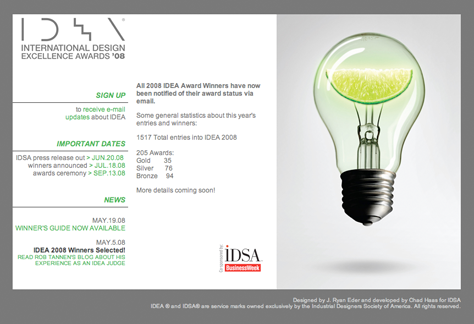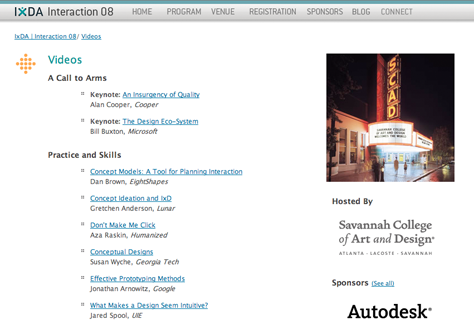The Alphabet Soup: Too Many UX Groups?
UX practitioners have numerous options for getting involved in our professional community. For those who define the interactions, behaviors, and workflows of digital products, there’s the Interaction Design Association![]() (IxDA). The Information Architecture Institute
(IxDA). The Information Architecture Institute![]() (IAI) serves those who structure digital information spaces such as Web sites and intranets. For those involved in usability, user research, and analysis, there are the Usability Professionals’ Association
(IAI) serves those who structure digital information spaces such as Web sites and intranets. For those involved in usability, user research, and analysis, there are the Usability Professionals’ Association![]() (UPA) and the Human Factors and Ergonomics Society
(UPA) and the Human Factors and Ergonomics Society![]() (HFES). The visual design community has AIGA,
(HFES). The visual design community has AIGA,![]() which was formerly known as the American Institute of Graphic Arts, but now touts itself as the Professional Association for Design. AIGA was a sponsoring organization of the Design for User Experience (DUX) conferences in 2003, 2005, and 2007. One of the oldest and most well-established groups is ACM SIGCHI,
which was formerly known as the American Institute of Graphic Arts, but now touts itself as the Professional Association for Design. AIGA was a sponsoring organization of the Design for User Experience (DUX) conferences in 2003, 2005, and 2007. One of the oldest and most well-established groups is ACM SIGCHI,![]() the Association of Computing Machinery Special Interest Group on Computer Human Interaction. While ACM has been around since 1947, the CHI Special Interest Group was created in 1982. And, recognizing the need to facilitate conversations and collaboration between all of these professional groups and associations, both nationally and internationally, UXnet
the Association of Computing Machinery Special Interest Group on Computer Human Interaction. While ACM has been around since 1947, the CHI Special Interest Group was created in 1982. And, recognizing the need to facilitate conversations and collaboration between all of these professional groups and associations, both nationally and internationally, UXnet![]() launched in 2004. This is just a sampling of some of the best-known organizations. There are others.
launched in 2004. This is just a sampling of some of the best-known organizations. There are others.
Local groups exist as well. For example, in the Boston area where I live, there are bi-monthly meetings of the Web Innovators Group,![]() where startups demo their new technology for peers and interested venture capitalists. There are also general-interest tech organizations like the Massachusetts Innovation and Technology Exchange
where startups demo their new technology for peers and interested venture capitalists. There are also general-interest tech organizations like the Massachusetts Innovation and Technology Exchange![]() (MITX), and the Massachusetts Technology Leadership Council.
(MITX), and the Massachusetts Technology Leadership Council.![]() If you are interested in connecting with your peers and learning in an informal setting, a local BarCamp
If you are interested in connecting with your peers and learning in an informal setting, a local BarCamp![]() or Meetup
or Meetup![]() may be for you.
may be for you.
All of these organizations compete with each other—whether directly or indirectly—for the attention, volunteer time, and resources UX professionals have to offer. If you’re actively involved in the UX community, it’s easy to feel pulled in too many directions at once.
At the Boston UPA Conference 2008: Usability and User Experience,![]() held in May at Bentley College, the panel “Critical Conversations About UCD: Challenging Assumptions, Fondly Held Beliefs, and Common Practices”
held in May at Bentley College, the panel “Critical Conversations About UCD: Challenging Assumptions, Fondly Held Beliefs, and Common Practices”![]() discussed the topic of divergent professional associations with the audience, asking the question, “Does this wide array of organizations inhibit our ability to advocate our professions’ business value?” From the session description:
discussed the topic of divergent professional associations with the audience, asking the question, “Does this wide array of organizations inhibit our ability to advocate our professions’ business value?” From the session description:
“Those of us who have been in the field for several decades see splintering into more and more specialized (and insular) societies, conferences, and languages. We keep coming up with more and more titles to describe what we do, and rediscovering concepts that have been around instead of innovating beyond them. We are splintering into sub-groups who debate the meaning of design or usability endlessly instead of working together to build a shared understanding of the extensive body of knowledge the profession has amassed over the past several decades and come up with a way to clearly explain our value to outsiders.”
Panelist James McElroy noted that the Industrial Designers Society of America![]() (IDSA), which formed from several smaller groups in 1965, does an admirable job of advocating for the business value of the profession. For instance, their annual International Design Excellence Awards
(IDSA), which formed from several smaller groups in 1965, does an admirable job of advocating for the business value of the profession. For instance, their annual International Design Excellence Awards![]() were featured in BusinessWeek magazine. Figure 1 shows some information about the awards on the IDSA Web site.
were featured in BusinessWeek magazine. Figure 1 shows some information about the awards on the IDSA Web site.

While it seems extremely unlikely all of these user experience groups and associations will simply converge—into say the United Digital Workers or the UX Union—would we be better off professionally if they did?
At present, it seems we are at a stage in the evolution of the UX professions when the existence of many groups may be a necessity—despite the difficulties in coordinating between them or the dearth of available volunteer time. The UX community may not be ready to join together under one umbrella. A look back at the history of the various industrial design associations that were the predecessors of IDSA![]() shows a similar evolution, beginning in 1927 when groups like the National Furniture Designers Council (NFDC), the Society of Industrial Designers (SID), and the Industrial Design Education Association (IDEA) were active.
shows a similar evolution, beginning in 1927 when groups like the National Furniture Designers Council (NFDC), the Society of Industrial Designers (SID), and the Industrial Design Education Association (IDEA) were active.
The current slate of UX groups is fulfilling different needs that a larger organization might neglect—needs whose satisfaction might require an organization to refracture itself into Special Interest Groups anyway. Some organizations like UPA are concerned with building public awareness of their field. Others like SIGCHI—which, along with its sibling, SIGGRAPH, has a life that is far more vigorous than the parent organization in which it is merely a special interest group—are more inwardly focused, providing a forum for professional discussion and development. UXnet is a central aggregation point for news of the field. The Web Innovators Group focuses on business development and networking. For a group like IxDA, a consolidation of UX organizations would be anathema, because its members have, for several years, been fighting to get their design role recognized as being distinct from other types of design.
As the history of IDSA shows, perhaps we are, indeed, simply in the early, fractured phase of an inevitable convergence. But if so, it seems the big consolidation is not yet upon us, and perhaps still more specialization will occur before it arrives.

